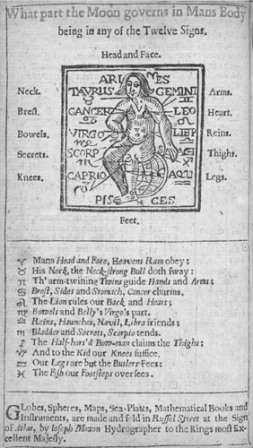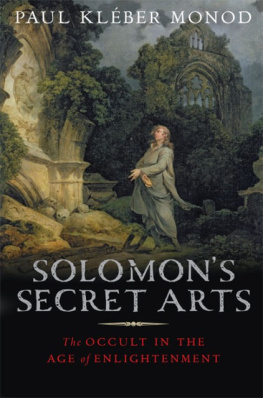

Copyright 2013 Paul Klber Monod
All rights reserved. This book may not be reproduced in whole or in part, in any form (beyond that copying permitted by Sections 107 and 108 of the U.S. Copyright Law and except by reviewers for the public press) without written permission from the publishers.
For information about this and other Yale University Press publications, please contact:
U.S. Office:
Europe Office:
Set in Minion Pro by IDSUK (DataConnection) Ltd
Printed in Great Britain by TJ International Ltd, Padstow, Cornwall
Library of Congress Cataloging-in-Publication Data
Monod, Paul Klber.
Solomon's Secret Arts: The Occult in the Age of Enlightenment/Paul Kleber Monod.
pages cm
ISBN 978-0-300-12358-6 (hardback)
1. Magic. 2. ScienceHistoryMiscellanea. 3. Alchemy. 4. Occult sciences. 5. Enlightenment. I. Title.
BF1611.M65 2013
130.9dc23
2012043028
A catalogue record for this book is available from the British Library.
10 9 8 7 6 5 4 3 2 1
To Jan and Evan, as always.
C ONTENTS

I LLUSTRATIONS

Engraving of an alchemical adept and a student from Elias Ashmole, Theatrum Chemicum Britannicum (London, 1652). The British Library Board.
Engraving of a Behmenist alchemical diagram from The Philosophical Epitaph of W.C. Esq. (London, 1673). The British Library Board.
Page from John Gadbury, , Or, A Diary Astronomical and Astological, For the Year of Grace 1668 (London, 1667), showing the astrological man. The Huntington Library, San Marino, California.
Frontispiece portrait engraving from John Heydon, Theomagia: Or, The Temple of Wisdom (London, 1664). The British Library Board.
Frontispiece engraving of six scenes of apparitions from Joseph Glanvill, Saducismus Triumphatus: The Second Part (London, 1681). The British Library Board.
Frontispiece engraving of the Palace of Secrets from Knorr von Rosenroth, Kabbala Denudata, vol. 1, part 1 (Salzbach, 1677). Collection of German Literature, Beinecke Rare Book and Manuscript Library, Yale University.
Frontispiece engraving of the Tree of Life from Baro Urbigerus, Aphorismi Urbigerani (London, 1690). The British Library Board.
Engraving of two sigils from John Partridge, Merlinus Liberatus (London, 1698). The Huntington Library, San Marino, California.
Engraved plan of the Temple of Solomon from Sir Isaac Newton, The Chronology of Ancient Kingdoms Amended (London, 1728). The British Library Board.
Avebury as a serpent, an engraving from William Stukeley, Abury, A Temple of the British Druids (London, 1743). The British Library Board.
Frontispiece portrait from Duncan Campbel, Secret Memoirs of the Late Mr. Duncan Campbel, The Famous Deaf and Dumb Gentleman (London, 1732). The British Library Board.
Fold-out engravings of The Third Table from Jacob Behmen, Four Tables of Divine Revelation, in The Works of Jacob Behmen, vol. 3 (London, 1772). The British Library Board.
Engraved portrait of Ebenezer Sibly, from Ebenezer Sibly, The Medical Mirror (London, 1794). The Wellcome Library, London.
Joseph Wright of Derby, The Alchymist discovers Phosphorus, 1771. 09/2012 Derby Museums and Art Gallery, Derby.
Revolution of America, from Ebenezer Sibly, A New and Complete Illustration of the Occult Sciences (2 vols in one, London, 1790). The British Library Board.
Peter Lambert de Lintot, Chapter and Grand Lodge of England, engraving, 1789. The Library and Museum of Freemasonry, Freemasons' Hall, London.
Animal MagnetismThe Operator putting his Patient into a Crisis, engraving from Ebenezer Sibly, A Key to Physic, and the Occult Sciences (London, 1810). The Wellcome Library, London.
Urizen from William Blake, Europe: A Prophecy (1794). The British Library Board.

The aspiring young alchemical adept accepts a book of secrets from his aged master in this engraving from Elias Ashmole's Theatrum Chemicum Britannicum. Above them, angels rejoice and the Holy Spirit sends out celestial rays. The two columns and the lions suggest that the location is Solomon's Temple, while the borders are filled with the abundance of Nature. The alchemist's quest is at the center of the divine and natural universes.

Inspired by the illustrations to early editions of Jacob Boehme's works, this alchemical diagram from The Philosophical Epitaph of W.C. Esq. represents a Pythagorean or rather Copernican universe, in which Man, located between the celestial and elemental spheres, revolves around a solar God. The rudiments of alchemysulphur, stones, plants, metals, saltstand above the primeval chaos and the infernal fire in which Satan resides. They are elevated by mercury, which points directly towards the divine. This is evidently a spiritual as well as a natural quest.

The astrological man from John Gadbury's almanac for 1668. The moon as it passes through each zodiacal sign governs a different body part. At the bottom of the page is an advertisement for a mathematical instrument maker. The facing page, not shown here, contains a table of dignities, or the celestial mansions and houses in which the planets were located, along with advertisements: for a bookseller who marketed both ink and toothpaste, and for a table of astrological houses designed for the ingenious Arti[st]s in Astrologie.

A portrait of John Heydon, from his book Theomagia: Or, The Temple of Wisdom (1664). Richly attired and surrounded by his own books, he basks in celestial rays. Below the portrait is a coat of arms that marks him as an Esquire. The planetary signs that surround him form a kind of nativity chart. At the bottom left, an obedient dog labeled Lilly bows towards the Astromagus.

The frontispiece to the second part of Joseph Glanvill's Saducismus Triumphatus shows the Devil carrying out various types of mischief, including levitation. The drummer of Tedworth is at the upper left, and at the lower right, an angel appears to a disabled girl in Amsterdam, who is cured of her affliction. Evidently, some spirits can be benign, but human beings cannot enter into voluntary contact with them.

Next page



















